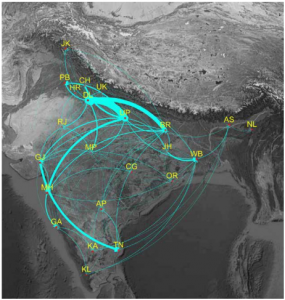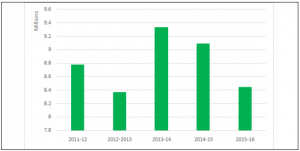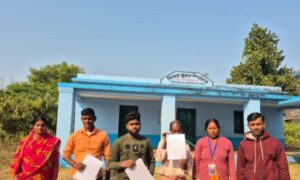
Top Inter-State Migration Routes with Highest Passenger Density, Economic Survey: 2016-2017
Recently, migrants from Bihar, Uttar Pradesh (UP) and Madhya Pradesh(MP) attacked in Gandhinagar, Mehsana, Sabarkantha, Patan and Ahmedabad districts of Gujarat. Following such assaults, a huge number of migrants forced to leave the state. It’s reported that the Kshatriya Thakor Sena, a fringe group, vandalized several shops of the non-Guajarati micro-entrepreneurs. Reportedly, the outfit alleged that Non-Gujaratis are grabbing and stealing the jobs of the locals. It’s not an isolated case where the migrants are facing the fury of the locals. It is reported that several fringe groups have stirred such attacks in the recent past.
In this backdrop, there is a need to focus on the pattern of the migration in India. The Economic Survey 2016-17 sheds light on the magnitude of the migration in India while using railway passenger data analysis which suggests an annual inter-state migration flow of close to 9 million since 2011. Clearly, rising growth after the 1980s has led to an acceleration of labour migration flows as the rewards of better economic opportunities have overcome the costs of moving. Such figures are staggering and the Survey paints a rosy picture of the migration and how the inter-state migration provide an opportunity.
Magnitude and Patterns of Migration:
In India, Gujarat is an industrialized state where a huge number of manufacturing companies are operational. As the state governments crafted industry-friendly policies, companies ventured into the state and the business activities intensified in various parts of Gujarat. With growing demand of the goods, they require semi-skilled workers to expand their businesses. Times of India reported that Migrants make up 70 percent of workforce in Surat, 50 percent in Ahmadabad.
On the other hand, a dwindling economy in the neighboring states aggravated the misery of people. As the agrarian economy faced severe challenges in states like Bihar, UP and MP, people from such states migrate and work in such industrial units. They explore avenues of the opportunity. Many of them start their own small eateries near the footpaths. It is evident that they easy prey for the disgruntled elements and the fringe groups.
Though the political leadership proudly illustrated about the Gujarat Model of Development at various national and international platforms like the World Economic Forum (WEF). A school of economists touted and compared the so-called Gujarat Model with other models in India. Under the auspice of the Gujarat Model, the good governance is an important determinant where the law and order is implacable. In the recent past, Gujarat witnessed upheavals of the social unrest like attacks on the Dalits and desperate demands for the reservation in the government jobs by Patel, an influential caste in Gujarat.
The above-mentioned graph shows that the largest interstate migration routes. States like Delhi, Maharashtra, Tamil Nadu, and Gujarat attract large swathes of migrants from the Hindi heartland of Uttar Pradesh, Bihar, and Madhya Pradesh.
As the Economic Survey 2016-2017 stated, “Historically, migration of people for work and education has been a phenomenon that accompanies the structural transformation of economies, and has paved the way for the release of “surplus labour” from relatively low-productive agricultural activities to sectors enjoying higher productivity. The resulting remittance flows increase household spending in the receiving regions and further the economic development of less-developed regions.”
Total Net Flows at All India Level:

Source: Economic Survey 2016-2017
The above-mentioned graph shows the all India net annual passenger flows for India for the last five financial years starting 2011-12. The recent spate of attacks which escalated exodus of the Non-Gujratis are defying the much-hyped Gujarat Model. Enforcing the law is a crucial ingredient of ensuring the good governance. It should not be a rhetoric. The state government should protect the migrants while ensuring the employment opportunities for the local. Any kind of the identity politics must be discouraged which seems a distant dream in India.


















